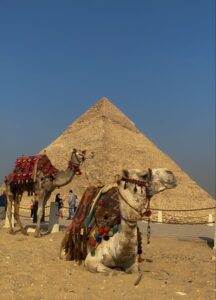Exploring Ancient Egypt: A Cultural Journey
Egypt, often referred to as the cradle of civilization, boasts a history that spans thousands of years. From majestic pyramids to intricate hieroglyphics, the remnants of ancient Egypt tell stories of a remarkable civilization that continues to fascinate the world. Join us on a cultural journey to explore the wonders of ancient Egypt.
1. The Birth of Civilization
Ancient Egypt emerged around 3100 BC, when Upper and Lower Egypt were unified under the first pharaoh, Narmer. This period marked the beginning of a civilization known for its advancements in writing, architecture, and governance. The Nile River, the lifeblood of Egypt, played a crucial role in its development, providing fertile land and enabling agriculture.
2. The Great Pyramids of Giza
No exploration of ancient Egypt is complete without a visit to the Great Pyramids of Giza. These colossal structures were built as tombs for the pharaohs and reflect the ingenuity and ambition of the ancient Egyptians. The Great Pyramid of Khufu, the largest of the three, originally stood at 146 meters and remains one of the Seven Wonders of the Ancient World.
Cultural Significance
The pyramids symbolize the belief in the afterlife and the divine status of the pharaohs. They were constructed using millions of limestone blocks, and their alignment with the stars reveals the Egyptians’ advanced understanding of astronomy.
3. The Valley of the Kings
Located on the west bank of the Nile in Luxor, the Valley of the Kings served as the burial ground for many pharaohs during the New Kingdom period. Here, you can explore the intricately decorated tombs, including that of Tutankhamun, which was discovered nearly intact in 1922.
Art and Architecture
The tombs are adorned with colorful frescoes and hieroglyphics, depicting scenes from the pharaohs’ lives and their journey to the afterlife. The art in these tombs provides invaluable insights into ancient Egyptian beliefs and customs.
4. Temples of Ancient Egypt
Temples were central to ancient Egyptian religious life and were dedicated to various gods and goddesses. The most notable temples include:
- Karnak Temple: This vast complex in Luxor was dedicated to the god Amun and features colossal statues, towering obelisks, and intricate hieroglyphics. It was a site for grand festivals and rituals.
- Hatshepsut Temple: This mortuary temple, built for the female pharaoh Hatshepsut, showcases stunning terraced architecture and reliefs that highlight her achievements.
5. The Role of Religion
Religion was deeply ingrained in every aspect of ancient Egyptian life. The Egyptians worshipped a multitude of gods and believed in an afterlife, leading to elaborate burial practices. The Book of the Dead, a collection of spells and prayers, was often included in tombs to guide the deceased through the afterlife.
6. Hieroglyphics: The Language of the Gods
Ancient Egyptians developed one of the earliest writing systems, known as hieroglyphics. This complex script combined logographic and alphabetic elements, used primarily for religious texts, monumental inscriptions, and record-keeping.
Deciphering the Past
The Rosetta Stone, discovered in 1799, was key to understanding hieroglyphics, as it contained the same text in Greek, Demotic, and hieroglyphic scripts. The work of scholars like Jean-François Champollion unlocked the secrets of this ancient language.
7. Cultural Legacy
The legacy of ancient Egypt continues to influence modern culture, art, and architecture. The fascination with its mythology, literature, and aesthetics can be seen in films, literature, and even fashion.
Modern Discoveries
Ongoing archaeological discoveries continue to shed light on this ancient civilization. From new tombs to artifacts, each find deepens our understanding of ancient Egyptian society and culture.
8. Experiencing Ancient Egypt Today
To truly appreciate the wonders of ancient Egypt, consider embarking on a guided tour with King Egypt Tours. Experience the magnificence of the pyramids, the grandeur of temples, and the serenity of the Nile, all while immersing yourself in the rich history that shaped one of the world’s most influential civilizations.
Conclusion
Exploring ancient Egypt is more than just a journey through time; it’s an opportunity to connect with a culture that laid the foundation for many aspects of modern society. From its monumental architecture to its profound religious beliefs, ancient Egypt remains a testament to human creativity and resilience. Prepare to be enchanted by the stories and wonders that await you in this timeless land.





